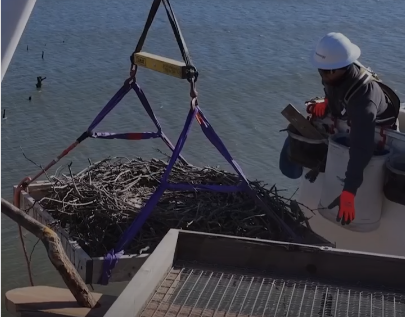Avian Protection Program
Evergy is committed to reducing harmful effects of electrical equipment on birds and their habitat.
Bird interactions with power lines can lead to injury or death for the bird, reduced nesting success, power outages, and other negative effects to birds and humans. We focus on three areas to prevent these from happening:
- Preventative: Ensure through construction standards and pre-construction evaluations that all new electrical construction is bird-safe.
- Proactive: Retrofit or rebuild existing equipment as appropriate when an area of high bird use or critical habitat is identified.
- Reactive: Retrofit or rebuild existing equipment to remediate negative bird interactions.
As part of our Avian Protection Program (APP), we partner with the U.S. Fish and Wildlife Service, U.S. Department of Agriculture-Wildlife Services, Missouri Department of Conservation, and Kansas Department of Wildlife, Parks and Tourism to provide nesting opportunities and public awareness through our three nest cameras.
We ask that our viewers keep in mind that these birds are wild creatures. We take great lengths to limit any interaction with them. Both owl and falcon chick success rates are low in nature and we work to avoid any additional disturbance during critical nesting season.

Topeka GO Falcon: Camera One

Topeka GO Falcon: Camera Two

Evergy Iatan Falcon Camera
Evergy Green Team installs the first known osprey nest in Kansas at Perry Lake with...

Right now, our live-streaming falcon cam buttons take you straight to our YouTube channels as we wait for them to begin nesting. Here's a recent screen shot of one of the Iatan birds checking out the nest.
Once an endangered species, Peregrine Falcons continue to recover after the banning of DDT in the 1970s and extensive efforts to reintroduce the birds throughout the eastern United States. Through our falcon cams and our avian protection program, Evergy is proud to be a part of this effort and continues to promote the conservation of this species as well as other Norther American raptors.
- From a low of 39 nesting pairs of peregrine falcons in the U.S. in 1972, more than 1,000 pairs exist today. Evergy has been an important part of this successful falcon recovery program.
- The female is bigger than the male, and incubation, which they share, generally takes 28 or 29 days.
- After hatching, the young fly in five to six weeks.
- Peregrine falcons feed mainly on birds taken in flight, with pigeons and starlings a favorite.
- They normally fly at 25-40 mph, but when in a dive for prey, they can fly at over 200 mph.
- They are relatively small, with males being about 1 1/2 lbs. and females being 2-2 1/2 lbs.
- Unlike larger raptors, their talons are relatively weak, so they kill their prey most often by striking it at high speed with their feet balled up into a "fist" then catching it as it falls.


